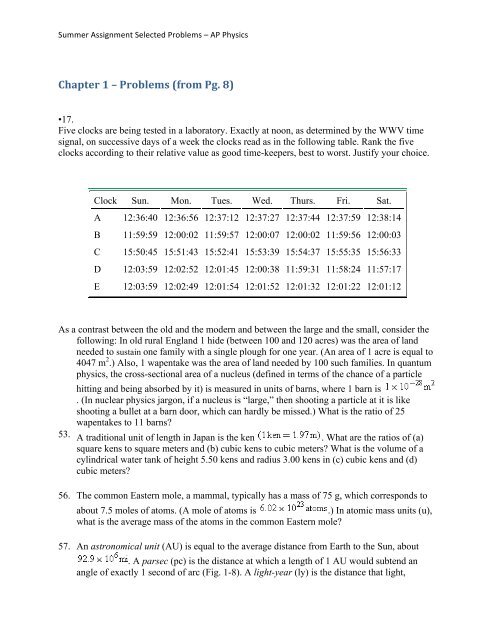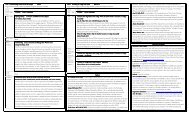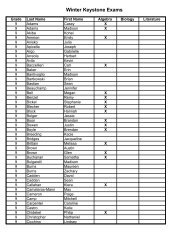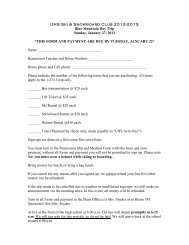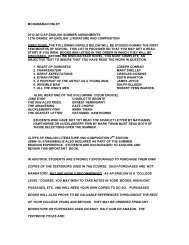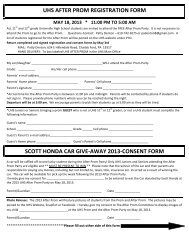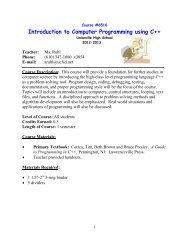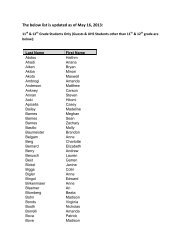Create successful ePaper yourself
Turn your PDF publications into a flip-book with our unique Google optimized e-Paper software.
<strong>Summer</strong> <strong>Assignment</strong> Selected <strong>Problems</strong> – AP Physics<br />
Chapter 1 – <strong>Problems</strong> (from Pg. 8)<br />
•17.<br />
Five clocks are being tested in a laboratory. Exactly at noon, as determined by the WWV time<br />
signal, on successive days of a week the clocks read as in the following table. Rank the five<br />
clocks according to their relative value as good time-keepers, best to worst. Justify your choice.<br />
Clock Sun. Mon. Tues. Wed. Thurs. Fri. Sat.<br />
A 12:36:40 12:36:56 12:37:12 12:37:27 12:37:44 12:37:59 12:38:14<br />
B 11:59:59 12:00:02 11:59:57 12:00:07 12:00:02 11:59:56 12:00:03<br />
C 15:50:45 15:51:43 15:52:41 15:53:39 15:54:37 15:55:35 15:56:33<br />
D 12:03:59 12:02:52 12:01:45 12:00:38 11:59:31 11:58:24 11:57:17<br />
E 12:03:59 12:02:49 12:01:54 12:01:52 12:01:32 12:01:22 12:01:12<br />
As a contrast between the old and the modern and between the large and the small, consider the<br />
following: In old rural England 1 hide (between 100 and 120 acres) was the area of land<br />
needed to sustain one family with a single plough for one year. (An area of 1 acre is equal to<br />
4047 m 2 .) Also, 1 wapentake was the area of land needed by 100 such families. In quantum<br />
physics, the cross-sectional area of a nucleus (defined in terms of the chance of a particle<br />
53.<br />
56.<br />
hitting and being absorbed by it) is measured in units of barns, where 1 barn is<br />
. (In nuclear physics jargon, if a nucleus is “large,” then shooting a particle at it is like<br />
shooting a bullet at a barn door, which can hardly be missed.) What is the ratio of 25<br />
wapentakes to 11 barns?<br />
A traditional unit of length in Japan is the ken . What are the ratios of (a)<br />
square kens to square meters and (b) cubic kens to cubic meters? What is the volume of a<br />
cylindrical water tank of height 5.50 kens and radius 3.00 kens in (c) cubic kens and (d)<br />
cubic meters?<br />
The common Eastern mole, a mammal, typically has a mass of 75 g, which corresponds to<br />
about 7.5 moles of atoms. (A mole of atoms is .) In atomic mass units (u),<br />
what is the average mass of the atoms in the common Eastern mole?<br />
57. An astronomical unit (AU) is equal to the average distance from Earth to the Sun, about<br />
. A parsec (pc) is the distance at which a length of 1 AU would subtend an<br />
angle of exactly 1 second of arc (Fig. 1-8). A light-year (ly) is the distance that light,
<strong>Summer</strong> <strong>Assignment</strong> Selected <strong>Problems</strong> – AP Physics<br />
traveling through a vacuum with a speed of 186 000 mi/s, would cover in 1.0 year. Express<br />
the Earth–Sun distance in (a) parsecs and (b) light-years.<br />
Chapter 3 –Questions (From Pg. 52)<br />
FIGURE 1-8 Problem 57.<br />
1. Being part of the “Gators,” the University of Florida golfing team must play on a putting<br />
green with an alligator pit. Figure 3-23 shows an overhead view of one putting challenge of the<br />
team; an xy coordinate system is superimposed. Team members must putt from the origin to the<br />
hole, which is at xy coordinates (8 m, 12 m), but they can putt the golf ball using only one or<br />
more of the following displacements, one or more times:<br />
The pit is at coordinates (8 m, 6 m). If a team member putts the ball<br />
into or through the pit, the member is automatically transferred to<br />
Florida State University, the arch rival. What sequence of<br />
displacements should a team member use to avoid the pit?<br />
5. If , does (a) , (b)<br />
, and (c) ?<br />
6. Describe two vectors and such that<br />
7.<br />
(a) and ;<br />
(b)<br />
(c) and .<br />
Which of the arrangements of axes in Fig. 3-25 can be labeled “right-handed coordinate<br />
system”? As usual, each axis label indicates the positive side of the axis.
<strong>Summer</strong> <strong>Assignment</strong> Selected <strong>Problems</strong> – AP Physics<br />
Chapter 3 –<strong>Problems</strong> (from pg. 53)<br />
sec. 3-4 Components of Vectors<br />
FIGURE 3-25 Question 7.<br />
•1. The x component of vector is −25.0 m and the y component is +40.0 m. (a) What is the<br />
magnitude of ? (b) What is the angle between the direction of and the positive direction<br />
of x?<br />
•3. What are (a) the x component and (b) the y component of a vector in the xy plane if its<br />
direction is 250° counterclockwise from the positive direction of the x axis and its magnitude is<br />
7.3 m?<br />
••7. A room has dimensions 3.00 m (height) × 3.70 m × 4.30 m. A fly starting at one corner flies<br />
around, ending up at the diagonally opposite corner. (a) What is the magnitude of its<br />
displacement? (b) Could the length of its path be less than this magnitude? (c) Greater? (d)<br />
Equal? (e) Choose a suitable coordinate system and express the components of the displacement<br />
vector in that system in unit-vector notation. (f) If the fly walks, what is the length of the shortest<br />
path? (Hint: This can be answered without calculus. The room is like a box. Unfold its walls to<br />
flatten them into a plane.)
<strong>Summer</strong> <strong>Assignment</strong> Selected <strong>Problems</strong> – AP Physics<br />
•9. (a) In unit-vector notation, what is the sum if and<br />
? What are the (b) magnitude and (c) direction of ?<br />
•11. A person desires to reach a point that is 3.40 km from her present location and in a direction<br />
that is 35.0° north of east. However, she must travel along streets that are oriented either north–<br />
south or east–west. What is the minimum distance she could travel to reach her destination?<br />
•13.<br />
Two vectors are given by:<br />
and<br />
In unit-vector notation, find (a) , (b) , and (c) a third vector such<br />
that .<br />
•17. The two vectors and in Fig. 3-30 have equal magnitudes of 10.0 m and the angles<br />
are and . Find the (a) x and (b) y components of their vector sum , (c) the<br />
magnitude of , and (d) the angle makes with the positive direction of the x axis.<br />
FIGURE 3-30 Problem 17.


